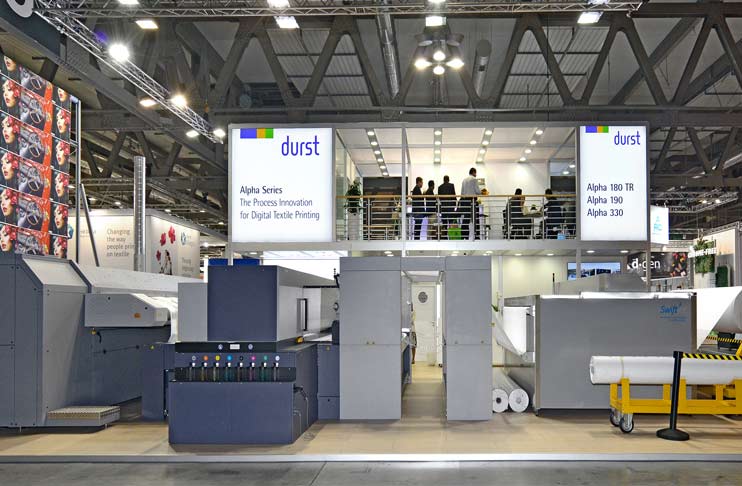Durst, the industrial inkjet specialist, and the English company Technijet Ltd., a manufacturer of industrial high-pressure cleaning systems, have founded a joint venture on the development of peripheral solutions for digital textile production. Technijet is known in the textile sector primarily for its ROTOVAC washing system which removes lint and dust from printing substrates. The common conceptual design of the patented Swiftjet pre-treatment system is the basis of the joint venture. The system was presented at ITMA 2015 in Milan by Durst as a feasibility study.
Swiftjet is a spraying and drying unit which is connected upstream of the actual printing machine and, depending on the desired printing result, takes over the chemical pre-treatment of the textile thread. Technijet’s long-term experience with high-pressure jets comes in useful when ensuring the exact application of the composition on the material surface.
Since the introduction of the Alpha Series at ITMA 2015, Durst has continuously striven to optimize the economic efficiency and environmental safety of inkjet print production. For example, by introducing the soft pigment ink system (Alpha P), which can be printed on standard material like cotton and polyester without additional binders and wet processes. Alpha P is convincing with its soft grip and color brilliance and at the same time, it reduces water and energy consumption in production. With the market introduction of the Swiftjet Solution, flexibility is further increased, since pre-treatment can be added upstream depending on material and need. Previously independent processes can thus be consolidated and automized which also contributes to an environmentally friendly production.
The Swiftjet pre-treatment system is adapted for the Durst Alpha Series high-performance inkjet printer and can process print widths of up to 330 cm. Durst will also offer the pre-treatment system as a standalone solution for existing third party technologies.
“In all market segments, our highest aim is to replace ‘old’ technologies with new, disruptive systems”, says Christoph Gamper, CEO of Durst Phototechnik AG. “This isn’t just about switching from ‘analog’ to ‘digital’ – it’s a redefinition of the production processes. In this redefinition, economic efficiency and environmental criteria are not mutually exclusive, but complementary. With our printing systems and the new pre-treatment technology we can significantly reduce our ecological footprint, particularly in textile printing.
“Since ITMA 2015, we have continued on our chosen path and have maximized the potential of inkjet technology”, says Martin Winkler, Segment Manager Textile Printing, Durst Phototechnik AG. “With the Alpha Series, we’re providing productivity, the soft pigment ink system adds flexibility and Swiftjet offers, the process optimization for increasing economic efficiency in textile printing. In many textile markets the additional ecological benefit provided by our technologies is not just a side effect anymore but it is a central requirement for complying with new regulatory and environmental requirements and to live up to new social awareness.”


